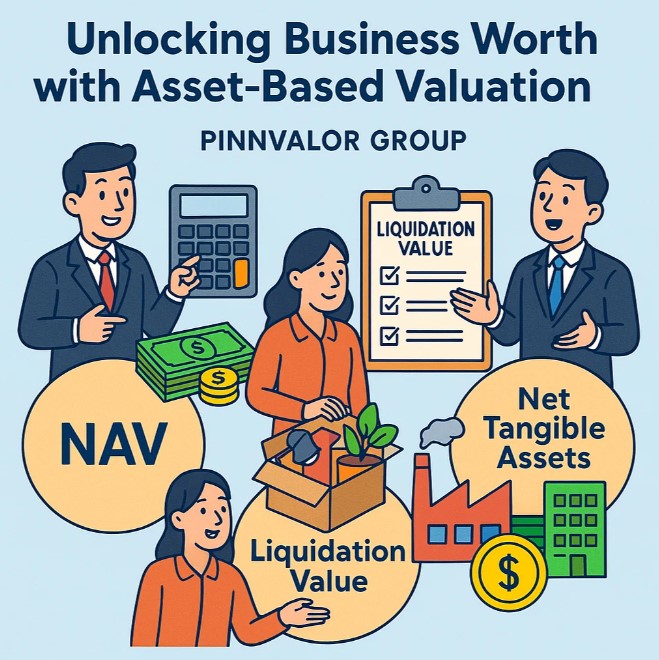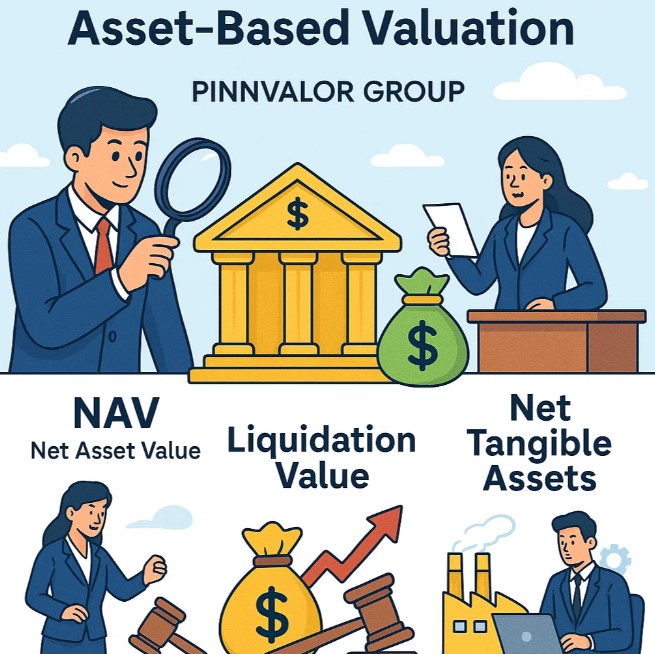
🔍 Unlocking Business Worth with Asset-Based Valuation: NAV, Liquidation Value & Net Tangible Assets
When it comes to valuing a business, especially one with significant physical or financial assets, asset-based valuation methods offer a grounded and tangible approach. Unlike earnings-based or market-based methods that focus on future potential or peer comparisons, asset-based valuation looks inward—assessing the real, underlying worth of what the business owns.
In this blog, we’ll dive into the three core methods under the asset-based valuation umbrella:
What if a company’s true value lies not in its future profits, but in what it owns today?
Not all value is found in earnings — sometimes, the strength of your assets is the ultimate foundation. Asset-based methods provide clarity where projections fall short.
- Net Asset Value (NAV)
- Liquidation Value
- Net Tangible Assets (NTA)
📘 What is Asset-Based Valuation?
Asset-based valuation determines a company’s value based on the net value of its assets minus its liabilities. It’s particularly useful in scenarios like:
- Company liquidation or bankruptcy
- Mergers and acquisitions (especially asset purchases)
- Valuing holding or investment companies
- Financial restructuring or collateral-based lending
This method answers a fundamental question:
“If we had to sell off all the assets today, what would the business be worth?”
🧮 1. Net Asset Value (NAV)
Definition:NAV refers to the difference between a company’s total assets and total liabilities, usually recorded at book value.
Formula:
NAV = Total Assets – Total Liabilities
Use Case:
- Commonly used for investment companies, real estate firms, and mutual funds
- Helps investors assess the “per share” value of the assets owned by the entity
Considerations:
- Book values may not reflect current market values
- Intangible assets (like goodwill) may distort NAV unless adjusted
🏚️ 2. Liquidation Value
Definition:Liquidation value estimates the net amount that can be recovered if the company’s assets were sold off quickly, often under distress or forced-sale conditions.
Formula:
Liquidation Value = Estimated Sale Proceeds of Assets – Liabilities
Use Case:
- Applied in bankruptcy proceedings, insolvency analysis, or distressed M&A
- Offers a conservative floor for business valuation
Considerations:
- Assumes a discount on fair market value due to urgency
- Not suitable for healthy, going-concern businesses

🧾 3. Net Tangible Assets (NTA)
Definition:NTA refines NAV by excluding intangible assets such as patents, trademarks, goodwill, and deferred tax assets.
Formula:
NTA = Total Tangible Assets – Total Liabilities
Use Case:
- Ideal for asset-heavy industries like manufacturing, construction, and logistics
- Provides a clear picture of the physical backing of the business
Considerations:
- Intangible-heavy businesses (e.g., tech or brand-driven firms) may appear undervalued
- Requires accurate classification and fair value estimation
🧠 Choosing the Right Method
| Scenario | Recommended Approach |
|---|---|
| Valuing a mutual fund or REIT | Net Asset Value (NAV) |
| Assessing a company in liquidation | Liquidation Value |
| Evaluating tangible-asset-heavy firms | Net Tangible Assets (NTA) |
🔍 Key Benefits of Asset-Based Valuation
- Clarity and simplicity – Easy to calculate with accessible financial statements
- Stability – Less sensitive to market sentiment or projections
- Objectivity – Focuses on what the company actually owns and owes
⚠️ Limitations to Keep in Mind
- Ignores future earnings potential
- May undervalue intellectual property or brand equity
- Relies on historical cost rather than market values unless revalued
- Less suitable for service-based or growth-driven businesses
📌 Final Thoughts
While asset-based valuation may not capture the future promise of a business, it provides a critical foundation for understanding its current financial solidity. Whether you're navigating distressed M&A, valuing investment holdings, or looking for a conservative benchmark, methods like NAV, Liquidation Value, and Net Tangible Assets offer reliable and realistic metrics.
🔗 Stay grounded in valuation—because what a business owns today can still tell a powerful story.
